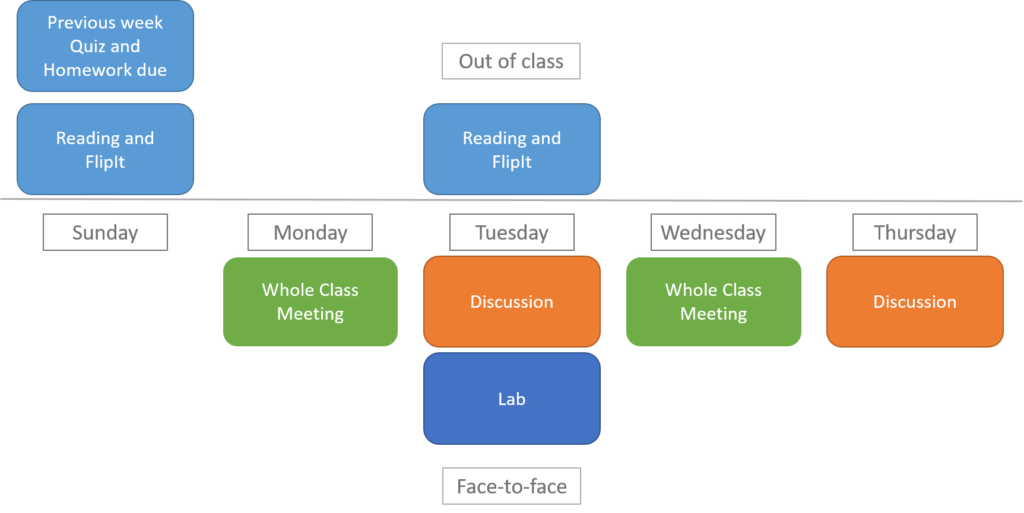Course Format and Philosophy
The Weekly Rhythm For Students
As you know, the Physics 103 and 104 courses have three face-to-face components during a typical week: Two 50 minutes lectures, or Whole Class Meetings, two 50 minutes Discussions, and one two hour Design Lab. The activities in involved in each element, as well as the out of class activities, are designed to build on one another. The goal of this flow is that by the end of the week students are able to meet the weekly learning objectives. Most weeks follow a consistent pattern. That level of consistency means that each week students can anticipate what is expected of them and can plan how to allot their time.
Although lab and and disucssion varies, a typical weekly for a student in Physics 103 and 104 could look something like this:

Weekly pages in the Canvas Course Hub
The Course Canvas Course Hub is central to the Student Weekly Rythm. There is a Canvas page for each week, and it too follows a consistent patterns. It is designed so that students can quickly find the Big Ideas for the week, the Weekly Learning Objectives, the Out of Class Assignments, Follow up from Whole Class Meeting and Discussion, and even some optional and interesting extention materials called, “Physics in the real world.” Below is a fully functiong example of a Canvas weekly page from Physics 103. Please note that the layout looks slightly different than the layout in Canvas. The design is responsive and adjusts to fit the presentation mode:
Energy and Momentum | Feb. 26-Mar. 4
This week you will meet the two great conservation laws of mechanics: Conservation of Energy and Conservation of Momentum. Although these laws can both be derived from the Newtonian mechanics that you already know, they express two very profound new ideas. You will find these to be powerful tools that allow you to understand and solve problems that would be difficult or impossible to solve using Newton’s Laws alone.
This Week’s Big Ideas
- Energy can be stored in the form of potential energy, the ‘potential’ for an object to do work.
- Conservation of Mechanical Energy: in a mechanical system, the total mechanical energy (kinetic and potential) is constant unless non-conservative forces (like friction or drag) act of the system.
- Non-conservative forces convert mechanical energy into or from other forms or energy, such as thermal or chemical energy.
- Conservation of Energy: the total energy of a system (mechanical plus thermal, chemical and other forms of energy) is constant.
- Conservation of Momentum: the total momentum of an isolated system is constant.
By the end of this week you will be able to:
- Use conservation of energy to predict an object’s speed, max height, and/or distance travelled.
- Compute the potential energy of gravity and springs.
- Compute the amount of work done by conservative and non-conservative forces.
- Compute the momentum of an object or system.
- Use conservation of momentum to predict the outcome of collisions between objects.
- Relate the average force on an object or system, the time over which the force is exerted, and the change in momentum of the object or system.
- Use graphical depictions of the force exerted on an object or system over time to determine the change in momentum of the object or system.
Graded items are identified below with a  icon.
icon.
You will find this example in your reading this week: A car experiencing non-negligible friction coasts down a hill, over a small crest, then downhill again, and comes to a stop at a gas station. Identify the forms of energy the car has, and how they are changed and transferred in this series of events.
Physics in the Real World:
- How to store energy with train tracks and a chunk of concrete
- Resuscitating the Ballistocardiograph
- Ballistocardiographs…in spaaace (or close enough)
- You’ll believe a squid can fly (original non-squid reference)
- Conservation of momentum…also in spaaace
- Tumbling and center of mass (from lecture)
- Gait analysis video (from lecture)
Prepare for and engage in lectures and discussions |
|
Sunday – Monday |
Lecture 6a: Energy
|
Tuesday |
Discussion 6a: Energy
|
Wednesday |
Lecture 6b: Momentum
|
Thursday |
Discussion 6b: Momentum
|
Attend and complete the lab |
|
Various Days |
Lab 4: Loop-de-LoopAt the end of your lab section, click here to upload a picture of your Lab 4 whiteboard.
|
Complete the weekly homework in Expert TA |
|
Due Sunday |
Go to the Week 6 Homework Set
To prepare for this homework:
|
Complete the weekly quiz |
|
Due Sunday |
When you’re ready, please begin the Week 6 Quiz
This quiz will test your understanding about the learning objectives for the week. You will have 24 hours to complete the quiz from the moment you open it, even if you stop working and come back to it later. After the quiz closes, you can find solutions here.
|

